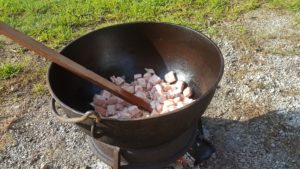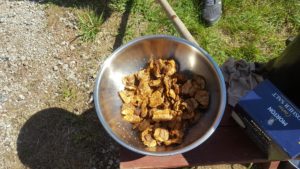As a finale to our hog butchering we rendered lard today.
If you’ve never rendered lard it’s the process of cooking pig fat until it liquefies. Then you strain it and chill it, and you end up with the very essence of piggy goodness for frying or for anything you use cooking oil [1]. Popcorn, popped in lard, is sublime.
You start by cutting all the fat from the pig into cubes. The smaller the cubes, the faster it renders. But on the other hand, the smaller you cut the cubes, the longer it takes to finish butchering. We [2] were weary on our feet by the time we cut up two hogs, so the fat cubes were about 2 inches on a side.
Once you have a bunch of pig fat you build a fire under your butchering kettle. The kettle is cast iron and about 3 feet in diameter [3]. You can move it by yourself, but once it’s over the fire and too hot to touch, it’s a two man lift.
You throw your pork fat cubes into the kettle and start stirring so they don’t burn.

See how beautifully clean that kettle is [3.5]!
You stoke the fire and keep the fat at a slow simmer, and in an hour or so the fat is browning nicely.

We had pieces that were mostly meat, and at this point we were pulling those out and salting and eating them. The most ridiculously delicious thing you can imagine [5].
Once you’ve rendered all the lard (you can tell you’re done by pressing a chunk of fat against the side of the kettle, if white fat squishes out, you’re not done) put the fat chunks in your lard press [6] and squeeze all the lard out. Then tip your fat chunks, which are now cracklin’s, into a bowl, salt them, and eat!

But that’s just a bonus. The main point is to gather lard. We strained the lard through cheesecloth and ended up with about 2 gallons of lard. Once you strain it and chill it, it’s a lovely white color.

It’s disturbing to raise your own meat. You take care of your animals, you make sure they’re well fed, have clean water, and have a dry and warm place to sleep. And then you kill and eat them. But meat doesn’t come wrapped in plastic in a grocery store. Using every last bit of pork, even to rendering the lard, respects that for us to eat, something had to die.
1. We all know animal fats are a sure route to a heart attack, and the only guarantee of a long and healthy life is to use margarine. Well, no, not margarine as we recently learned. Trans fats, from which margarine is made, are death itself. The only guarantee of a long and healthy life is to not consume trans fats. Whatever you do, don’t eat margarine, or lard. Only use Crisco which consists of a blend of soybean oil, fully hydrogenated palm oil, and partially hydrogenated palm and soybean oils. Then you will live long and prosper.
2. As usual, when I say “we” I mean “me.”
3. If you think about it for a moment, you might think, “How often do you use a butchering kettle? And where do you store it between times?” The answers to that are “Almost never.” and “In the barn.” So getting the kettle ready meant that we[4] wire brushed it for half an hour and scrubbed it with fat and salt and rinsed and scrubbed and rinsed and scrubbed.
3.5 You did read footnote 3, didn’t you?
4. In this case “we” does not mean “me.” It’s not my filthy kettle. Tom did all that.
5. If eating this is wrong, I don’t want to be right.
6. You do have a lard press, don’t you?
Leave a Reply